Popular games published by company GCE
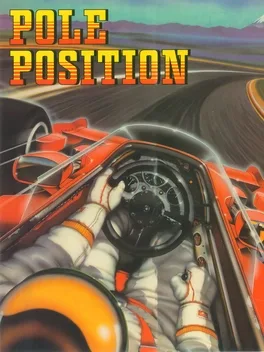
The very first racing game with the rear perspective camera and track based on real life.
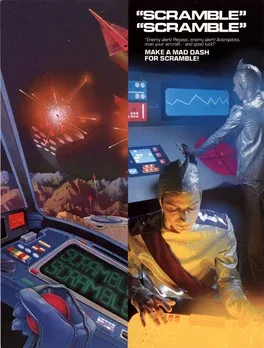
The player controls an aircraft, referred to in the game as a "Jet," and has to guide it across a scrolling terrain, battling obstacles along the way. The ship is armed with a forward-firing weapon and bombs; each weapon has its own button. The player must avoid colliding with the terrain and other enemies, while simultaneously maintaining its limited fuel supply which diminishes over time. More fuel can be acquired by destroying fuel tanks in the game. The game is divided into six sections, each with a different style of terrain and different obstacles. There is no intermission between each section; the game simply scrolls into the new terrain. Points are awarded based upon the number of seconds of being alive, and on destroying enemies and fuel tanks. In the final section, the player must destroy a "base". Once this has been accomplished, a flag denoting a completed mission is posted at the bottom right of the screen. The game then continues by returning to the first section once more, with a slight increase in difficulty.
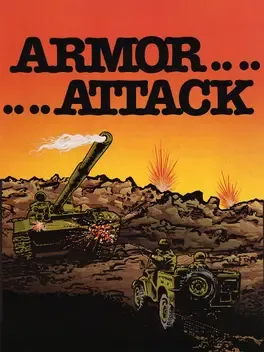
The player controls a jeep and must destroy the many tanks and helicopters that attack them in a maze-like cityscape. The jeep is armed with a rocket launcher that fires straight forward; the player can have two rockets on-screen at the time. The driving is generally similar to the well-known Combat for the Atari 2600. Tanks periodically spawn from different locations on the edge of the screen and drive towards the player. The tanks always travel along horizontal or vertical lines, unlike the freely moving jeep. Tank turrets move to track the player, allowing them to shoot in any direction. Tanks normally take two hits to kill, and the player can have only two rockets on the screen at a time. The helicopter spawns from any point, and approaches the player in looping paths flying over the jeep and periodically firing. If hit, the helicopter spirals in.
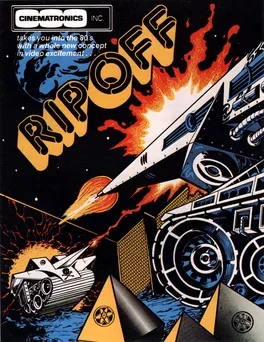
Rip-Off is a vector shoot 'em up released in arcades by Cinematronics in 1980. It is the first shoot 'em up arcade game to feature cooperative gameplay and the first game to exhibit "flocking" behavior. The objective is to prevent computer-controlled enemies from stealing eight canisters set in the center of the screen. One or two players control tank-like vehicles while game-controlled "pirate" tanks rush onto the field and attempt to drag the canisters off the edge of the screen. Enemies can be defeated by shooting or colliding with them. The game speed and difficulty increase with each successive wave until all the canisters have been taken ("ripped off").
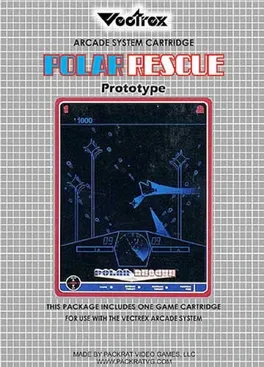
The player controls a submarine in hostile waters and must rescue the survivors of a mission which ended in disaster. Enemy submarines surround and will fire upon the player's ship if it enters sonar range. Each enemy submarine can fire up to five torpedoes; however, if it is destroyed before it uses all of their torpedoes, the remainder will be added to the player's arsenal. Other obstacles which must be avoided are mines, ice chunks and turbulent underwater whirlwinds. Once the survivors are located, it is necessary to dock with their pod, which the player has to approach with accuracy and care. A new mission will begin with a successful rescue.
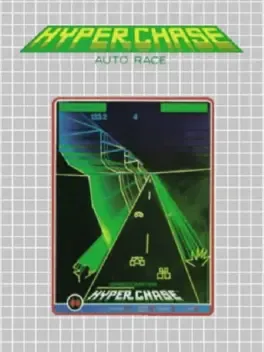
The player controls a formula one race car whose objective is to advance through the rankings and either make the best time or accumulate as many points as possible depending on the game selected. In Game 1, the player has unlimited cars and their goal is to finish the course in as little time as possible. In Game 2, the player receives 5 cars and the goal is to accumulate as many points as possible. In both games, collision with either the edge of the track or other cars results in the loss of a life and the player is forced to start from a speed of zero.
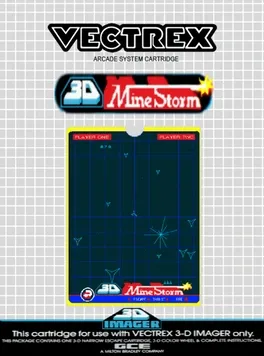
Mine Storm is the built-in game that came with every Vectrex unit. It was also released in a 3-D version that required the use of the Vectrex 3D Imager and as a bug-free replacement cartridge called Mine Storm 2 Gameplay: Gameplay is similar to the arcade game Asteroids. The player moves around the screen shooting at star-shaped Mines of various sizes and mannerisms. Each screen has many dots, which can potentially turn into Mines; once a Mine is shot, two dots on the screen will turn into medium-sized Mines, which will then turn into two small Mines when shot (note: for the most part; sometimes, perhaps due to a glitch, a medium-sized Mine will just hatch one small Mine). When all dots have been turned into Mines on a screen, the Minelayer will come out, laying additional Mines in it's wake until the player destroys it. Making contact with any Mine, fireball, or Minelayer will destroy the player's ship and the game will end once there are no more reserve ships left (note: on some later versions, colliding with any piece of space dust or alien forces will also destroy the player's ship as well [see Trivia section]). Extra ships are earned after every four levels are cleared. The Escape function acts as Hyperspace, which moves the player's ship to a random area on the screen in case of emergency.
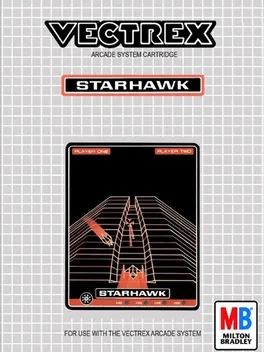
Starhawk is a 1979 vector arcade game by Cinematronics. Starhawk is a shoot 'em up with a fixed environment. The game was unique at the time as it presented the graphics in a pseudo-three dimensional way. Essentially, the game is a simple video game version of the Star Wars: Episode IV trench run. The game was later ported to the Vectrex video game console in 1982. The game is remembered as having quite advanced graphics for the time and being the first video game based upon or to have noticeable references to Star Wars.
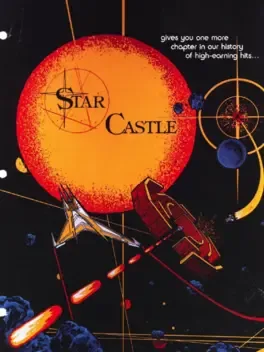
Star Castle is a 1980 vector arcade game by Cinematronics. The game involves obliterating a series of defenses orbiting a stationary turret in the center of the screen. The game was designed by Tim Skelly and programmed by Scott Boden. Tim Skelly also created a number of other Cinematronics titles, including Starhawk, Armor Attack and Rip-Off. As with many other titles by the company, Star Castle was ported to the Vectrex video game console in 1983.
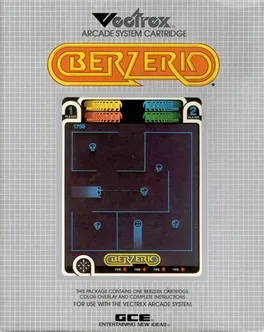
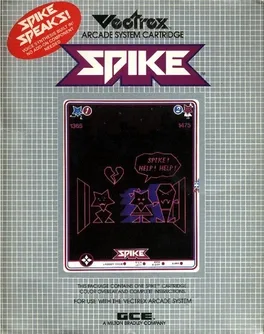
The evil Spud has taken Spike's girl, Molly, and Spike must make his way through various levels on platforms and ladders to rescue Molly. You must move the ladder from platform to platform and jump gaps to retrieve the key that will set Molly free from her cage. But be careful, Spud has evil bounces and birds he has sent out after you! You can defend yourself by kicking right or left. You can play either one player or two player mode where each player takes a turn with a single joystick controller. Who will save the fair Molly first and win her affection?
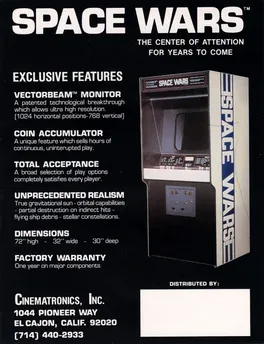
Space Wars is an early vector graphics arcade game. It is based on Spacewar!, a PDP-1 program. It was ported to the Vectrex in 1982. Space Wars was the brainchild of Larry Rosenthal, an MIT graduate who was fascinated with the original Spacewar! and developed his own custom hardware and software so that he could play the game. Cinematronics worked with Rosenthal to produce the Space Wars system. Two players controlled different ships. One button rotated the ship left, another rotated the ship right, one engaged thrust, one fired a shell, and one entered hyperspace (which causes the ship to disappear and reappear elsewhere on the playfield at random). The game offered a number of gameplay options, including the presence or absence of a star in the middle of the playfield (which exerted a positive or negative gravitational pull), whether the edges of the playfield "wrapped around" to their opposite sides, and whether shells bounced. Three other fascinating features were unique to this game. First, the game could not be played in "one player" mode; a human opponent was required. Second, the player's ship could take a glancing hit without dying, but would suffer damage; a cloud of loose ship fragments would break off and float away, after which the ship would be visibly damaged on screen and would turn and accelerate more slowly. Third and most memorable was that the duration of play for any contest was solely governed by the amount of money deposited; each quarter bought a minute and a half of play. A dollar bought six minutes, and for a ten dollar roll of quarters two players could play non-stop for an hour.
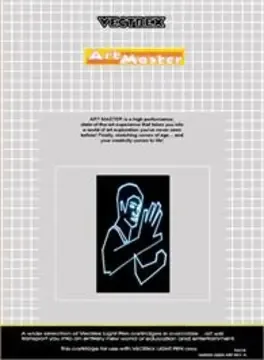
The Light Pen is an accessory for the Vectrex released in 1983 by GCE. It was quite revolutionary for its time, but because of the Great Video Game Crash of 1983, it ended up as a commercial failure. Packed in with the accessory was the game Art Master. During its lifetime, GCE managed to release three games for it: Art Master, Melody Master and AnimAction. There was also a prototype, Mail Plane, that never managed to get a release.
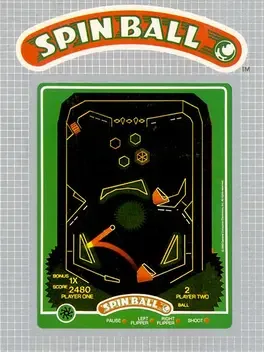
Spin Ball is a pinball simulation game. The games pinball table comes complete with a variety of bumpers, spinners, and other targets which can earn you varying amounts of points with several combinations possible for even more points. Bonuses can be earned as well, both in point form and also ball savers which block the chutes on the corners of the screen. A ball splitter may also appear, allowing you to have two balls in play at one time. The joystick is used to set the tension on the spring when putting a ball into play or to shake the table during play, and the buttons are used to control the left and right paddles on the table. You begin each game with 5 balls, and the game ends when all 5 are lost.
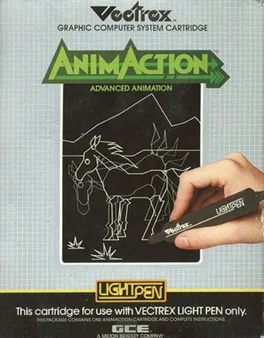
AnimAction is one of the Vectrex titles that requires the light pen accessory to operate. The light pen pack-in cartridge Art Master, only had rudimentary animation capabilities... AnimAction takes animating your vector based artwork to another level. An interesting fact about the AnimAction cartridge is that it is not an any of the the aftermarket multi-carts because it had extra memory built in to save your artwork, making it a more desirable program cartridge for your Vectrex collection. let's face it... there is something cool about seeing your own art moving about on the screen of a gaming console that is over a quarter century old! This is one of the software releases where GCE broke out of the "games only" mold and endeavored to make more interactive and educational programs for this awesome vector based platform.
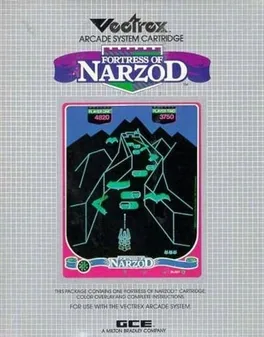
The player controls a hovercraft on its ascent up a mountain range with the goal of reaching the fortress at its summit. Each screen is part of a roadway, which is defended by three waves of guardians. These waves of guardians consist first of the Doomgrabbers, then the Tarantulas and finally the Ghouls. Each wave makes its descent down the roadway and towards the player, which all of one wave needs to be destroyed before the next wave begins its descent. Contact with enemies or the Spikers which are randomly released from the Doomgrabbers will result in the loss of a life. The player's own fire has the ability to ricochet off the walls of the roadway. This not only has the benefit of creating angles, which the player may destroy the enemies without them being able to return fire, but can also be a disadvantage due to the ability for the shot to return and destroy the player's ship. After three waves, the player is allowed to move up the screen and to the next roadway. Each roadway has the same enemies, although in increasing numbers. With the second roadway comes the addition of the Warbirds, who fly over the entire mountain and are able to fire at the player in the third roadway. Once three roadways have been
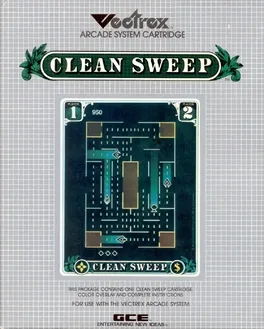
Clean Sweep is an arcade puzzle game. Move a vacuum through a maze in order to suck up dollar bills that are strewn throughout the screen. After several bills are vacuumed up, the vacuum will increase in size. After several size increases, the vacuum will become full and will not be able to vacuum up any more bills, so the money must be deposited in the vault in the center of the screen before the vacuum can start gathering up money again. The difficulty level increases by having the vacuum fill up quicker, causing the player to make multiple trips to the vault during a level.
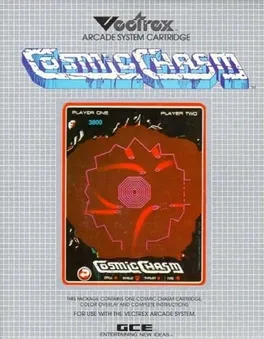
With the beginning of a new game, a map screen is shown with the player's position, as they control a ship set in a series of interconnected caverns. They must first plan out the best route in order to get to the central area in each Mission. After several seconds, the map screen changes to a cavern that the player is currently in, which each cavern has a core in the center that is constantly growing, as well as having several Planet Protector enemies. It is usually in the player's best interest to clear out each area of Planet Protectors by shooting them, then carefully inching their way to the protective barrier by an exit in order to drill through it. Once the barrier has been disabled by the drill, the player can then fly into the next cavern and thereby gets a step closer to the central area. The view changes from a cavern to the map screen with each cavern that they pass, showing the player's(') progress. Once the central central area is reached, the player(s) must drop a bomb at the center core, which they have several seconds in order to escape from the area before the bomb explodes. If the player does not make it out in time they will lose a ship; succeed and they will start again on a new area/Mission. Hitting a cavern wall, core or a Planet Protector will cause players to lose a ship and the game will end when there are no ships remaining. Exiting a Mission without leaving a bomb at the central core will cause the player to lose a ship as well, along with restarting the current Mission (if they have any remaining lives left). Also when the player loses a ship without clearing out all Planet Protectors in a cavern, that cavern's full complement of Protectors are totally replaced once the player's next ship comes into play. Players have a protective shield for use in emergencies, however.
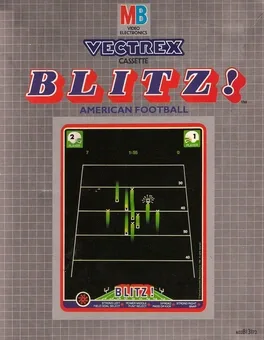
Blitz! is a simulation of American football. Each player (which the game supports a simultaneous two player mode) controls one member of their team on offense and defense and the basic objective is to move the ball up the field to reach the opposition end zone. This is done using a series of "downs", there being four downs available to move the ball ten yards forward. If a player fails to achieve that then the ball turns over to the opposition offense. The player can also score by opting to attempt to kick the ball between the opponent's goal (called a field goal and worth fewer points than a touchdown).
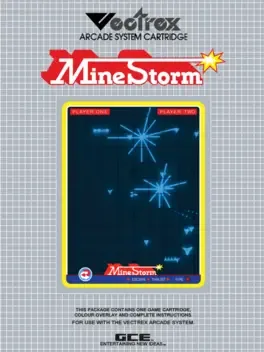
The game begins with a large enemy ship dropping mines onto the field as an ominous jingle plays, and moves from the top to the bottom of the screen, where it disappears. The player's ship starts in the middle of the field with 5 lives. Numerous mines then start popping up. The player must destroy all of the mines in order to progress to the next minefield. All of the mines can be destroyed with one shot, or hit with the player's ship, costing the player a life. There are 4 types of mines.